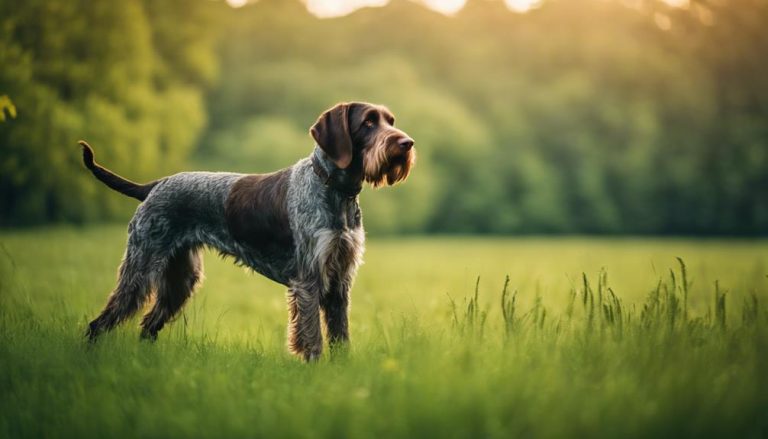Versatile Hunter: German Wirehaired Pointer
The German Wirehaired Pointer was developed in Germany during the 19th century, specifically for hunting in different types of environments. This breed is medium to large in size and is known for its unique, wire-like coat that protects it from harsh weather, and its exceptional ability to hunt.
These dogs are smart, faithful, and have a strong personality, needing plenty of exercise and mental stimulation to stay happy. They are excellent hunters due to their sharp sense of smell, their coat that keeps them safe from the elements, and their muscular build.
They live for about 12-14 years and need regular physical activity, proper grooming, and a healthy diet to stay in top shape. Getting to know their specific needs helps us appreciate their special traits and skills.
Key Takeaways
- German Wirehaired Pointers excel in hunting and intelligence.
- Need daily exercise for health and happiness.
- Loyal companions, forming strong family bonds.
Quick Facts
The German Wirehaired Pointer hails from Germany and is celebrated for its all-around hunting skills, sharp mind, and strong will. This dog is highly adaptable and excels in a variety of hunting tasks. Males stand tall at 23-26 inches at the shoulder, while females measure slightly smaller at 21-24 inches. This size contributes to their agility and stamina in hunting scenarios. Males weigh between 55-70 pounds and females between 45-60 pounds, highlighting their well-proportioned bodies that are fit for active outdoor pursuits.
As members of the Working group, these dogs are not just powerful but also boast a unique, weather-resistant coat that looks like wire. This coat type is perfect for hunting across different landscapes, offering protection from rough weather conditions. With a lifespan of 12-14 years, the German Wirehaired Pointer proves to be a resilient companion in hunting activities. Their mix of brains, brawn, and a specialized coat makes them outstanding hunting partners, showcasing their unmatched adaptability in the field.
Overview
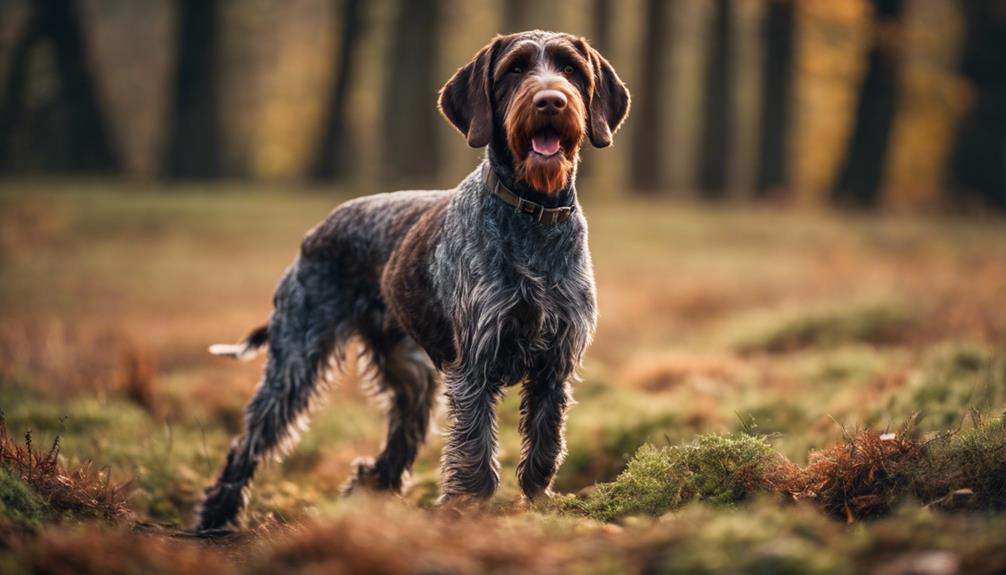
The German Wirehaired Pointer stands out in the hunting world due to its versatile skills and adaptability across various landscapes. This breed, which originated in Germany in the late 19th century, was bred with precision to excel in tasks that required close cooperation with hunters.
These dogs are medium to large in size and have a distinctive coat that is both weather-resistant and wire-like to the touch. Their build and coat make them ideal companions for outdoor activities across different weather conditions. The German Wirehaired Pointer comes in a variety of colors including liver and white, black and white ticked, and solid liver, each combination giving them a unique look.
Known for their intelligence and loyal nature, these dogs make great family pets. However, they thrive best with consistent training and early socialization to fit into home life smoothly. German Wirehaired Pointers live for about 12-14 years and need plenty of exercise and mental challenges to stay healthy and content, marking their importance in the Working dog category.
Versatile Hunting Companions
The German Wirehaired Pointer stands out for its all-around hunting skills, thriving in different settings and weather. Born in the late 1800s, this breed is smart, persistent, and highly adaptable. They can take on various hunting tasks, from finding game to fetching it, making them the top pick for hunters.
Their weather-resistant fur and strong body mean they can handle tough conditions. This, along with their excellent sense of smell and natural hunting instincts, makes them great at finding and retrieving game in varied landscapes.
| Trait | Benefit |
|---|---|
| Weather-resistant coat | Ready for any weather |
| Sturdy build | Can tackle rough landscapes |
| Sharp sense of smell | Excellent at tracking and fetching |
| Loyal and loving | Creates a strong bond with the hunter |
| Smart and determined | Can handle different hunting jobs |
German Wirehaired Pointers are the dream dog for hunters because they combine physical strength, sharp senses, and a strong emotional connection with their owners, proving themselves as indispensable partners in hunting adventures.
9th Century Origins
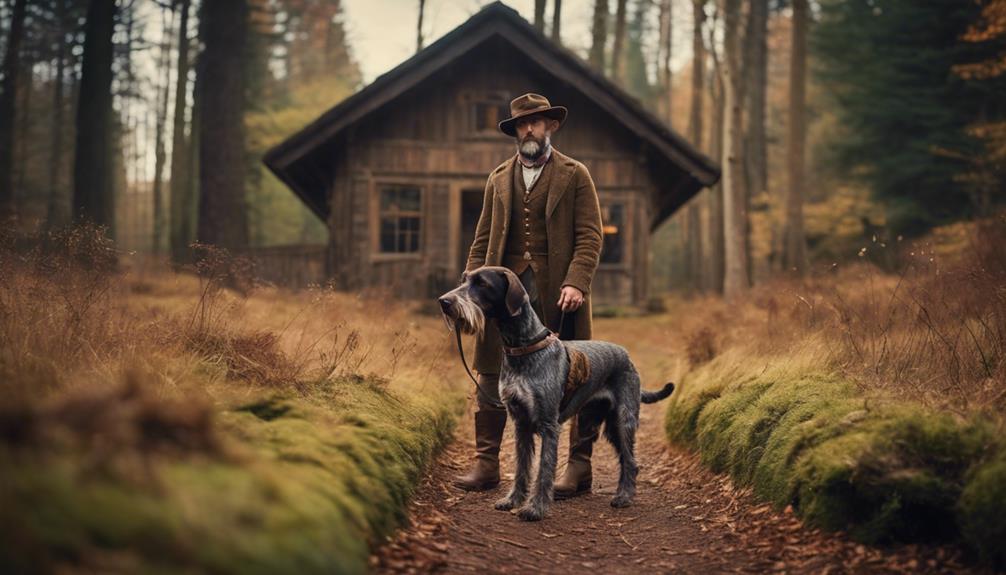
The German Wirehaired Pointer, emerging in the 19th century, marks a pivotal evolution in hunting dogs within Europe. This breed’s creation was a deliberate act by breeders aiming to improve hunting performance across various landscapes. Understanding the breed’s development involves considering:
- The timeline highlighting the breed’s key developments.
- The hunting roles envisioned by its creators for different environments.
- The ancestral dogs that played a part in its genetic lineage.
- The thorough selection and evaluation processes to perfect its traits.
The German Wirehaired Pointer’s history is a testament to the intentional and thoughtful efforts of breeders. They wanted a dog that could handle a range of hunting tasks. To appreciate the breed fully, one should look at the milestones in its history. These milestones show how breeders aimed to create a versatile hunting companion. Additionally, understanding the specific roles the breed was meant to fill highlights its utility in various hunting situations.
The breed’s ancestry is a blend of several notable dogs, each contributing unique qualities to the German Wirehaired Pointer’s genetic pool. This mix was no accident. Breeders carefully selected these ancestral breeds for their desirable traits. The evaluation processes these dogs underwent were rigorous. Breeders focused on refining the breed’s characteristics to meet high standards of hunting efficiency.
Breed Development Timeline
The German Wirehaired Pointer was first bred in Germany in 1880, with a goal to create a versatile hunting dog that could thrive in various environments. Guided by Baron Sigismund von Zedlitz und Neukirch, the breeders aimed for a dog that could hunt different kinds of game and easily adapt to new surroundings.
By crossing German Wirehaired Pointers with breeds like the Wirehaired Pointing Griffon and Pudelpointer, they improved their hunting skills and adaptability. The focus was on breeding dogs that were not only excellent at hunting but also had a good temperament, making them ideal companions and efficient working dogs.
The development process was thorough, with a strong emphasis on testing their hunting abilities and ensuring they could form a strong bond with their owners.
Historical Utility Purposes
In the late 1800s, German Wirehaired Pointers were developed to excel in various hunting conditions, thanks to their adaptability to different terrains. This breed emerged from Germany, crafted by Baron Sigismund von Zedlitz und Neukirch, who combined breeds like the Wirehaired Pointing Griffon and the Pudelpointer.
The goal was to create a versatile hunting dog that could handle various types of game and terrains, while also being a loyal companion. To ensure these dogs met high standards, they had to pass strict hunting and physical tests before they were allowed to breed. This was to maintain their hunting skills and good temperament, emphasizing the breed’s role in hunting circles.
Notable Ancestral Dogs
In the late 19th century, the German Wirehaired Pointer was developed, marking a significant chapter in the history of hunting dogs. This breed emerged from the vision of Baron Sigismund von Zedlitz und Neukirch, who aimed to create a dog that could excel in a variety of hunting scenarios. His goal was a versatile hunter, capable of navigating different landscapes and tracking down a range of prey.
Central to the creation of the German Wirehaired Pointer was the Wirehaired Pointing Griffon, a breed that significantly contributed to the genetic makeup of the German Wirehaired Pointer. Alongside the Pudelpointer, these breeds were carefully selected for their hunting skills, physical robustness, and adaptability. The breeding program was rigorous, focusing on producing dogs that were not only effective hunters but also possessed the desired physical traits and stamina to thrive in challenging environments.
This careful and thoughtful approach to breeding resulted in a dog breed that is still celebrated today for its hunting prowess and durability. The German Wirehaired Pointer stands as a testament to the success of selective breeding in achieving a specific set of characteristics in dogs, making it a cherished choice among hunters and dog enthusiasts alike.
Medium-Large Breed
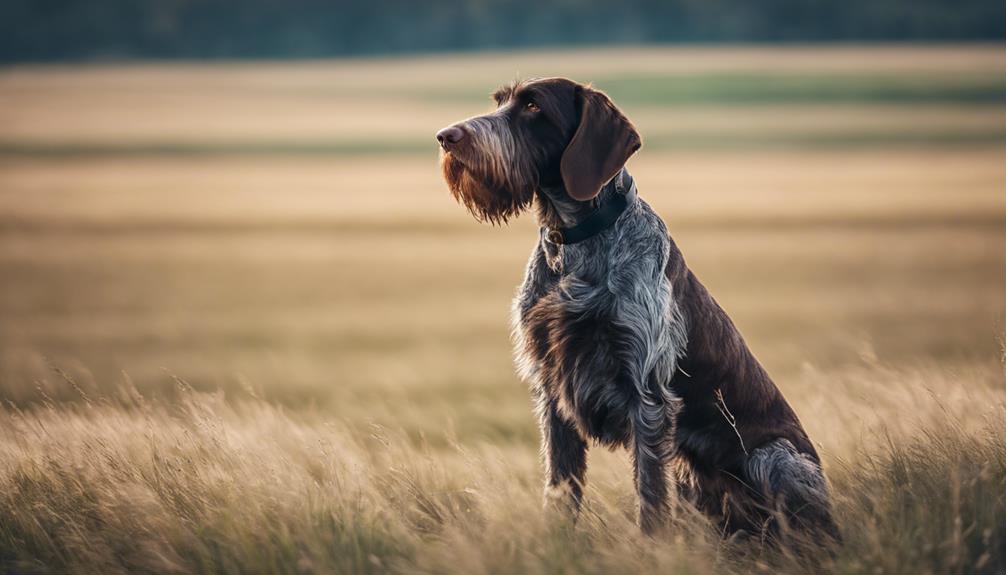
The German Wirehaired Pointer stands out among medium-large breeds due to its specific needs and characteristics. Originating from a history of being bred for hunting, these dogs are adaptable to various environments and make excellent companions. Below, we’ll cover the essentials:
1. Size and Build
These dogs have a sturdy build, reflecting their hunting heritage. Their size and strength require an owner who can handle a large, active dog.
2. Exercise Needs
German Wirehaired Pointers are energetic and need daily exercise. A long walk or a play session is necessary to keep them healthy and happy.
3. Grooming Demands
Their coat requires regular brushing to remove dead hair and minimize shedding. Occasional professional grooming might be needed to keep their coat in good condition.
4. Personality Traits
Known for their loyal and affectionate nature, they thrive on human interaction. They’re intelligent, making training a rewarding experience.
Understanding these aspects is key to providing a fulfilling life for a German Wirehaired Pointer, ensuring they’re a joyful addition to any home.
Size and Build
German Wirehaired Pointers stand out for their strong physique, falling into the medium to large dog breed category. Males typically measure 24-26 inches at the shoulder, while females tend to be a bit shorter, starting at 22 inches.
This difference in size between the two genders highlights the breed’s versatility in both appearance and physical skills. Weighing between 50-70 pounds, their muscular frame is a clear indicator of their capability for intense outdoor activities and hunting.
The physical characteristics of the German Wirehaired Pointer, notably their size and muscular build, play a crucial role in their effectiveness as gundogs, making them well-suited for a variety of hunting environments.
Exercise Requirements
German Wirehaired Pointers, with their robust frames and significant size, need a lot of exercise to stay healthy and happy. These dogs are naturally active and require daily physical activities to satisfy their energy levels. Having access to an outdoor space like a fenced yard is great for them, and taking them for walks every day is a must. It’s vital to keep them engaged not just physically but mentally too, due to their strong inclination towards being busy and completing tasks.
Structured exercise routines are critical in preventing boredom and possible behavioral issues in these dogs. A consistent exercise plan is key to their well-being, ensuring they lead joyful lives.
Grooming Needs
Keeping up with the unique coat of German Wirehaired Pointers involves a simple routine of brushing and the occasional need for stripping to keep them looking good and healthy. Their coat is tough, wiry, and made to keep water out, which is great for any outdoor adventure.
Their grooming needs aren’t too demanding, but sticking to a grooming schedule is key. Brushing them regularly gets rid of loose fur and stops their fur from tangling up, which means their skin stays healthy too. Sometimes, you’ll need to strip their coat to get rid of dead fur that’s trapped underneath. This might require a trip to a professional groomer to make sure their coat stays top-quality.
Keeping on top of grooming not only keeps these dogs looking sharp but also plays a big part in keeping them healthy.
Temperament Traits
German Wirehaired Pointers are known for their complex personality traits, which include being affectionate and steadfast. These qualities make them both a joy and a challenge to have around, especially for those who have experience with dogs. They are medium to large dogs that stand out for their devotion, energy, and smarts. They need a firm hand, socialization from a young age, and plenty of physical activity to grow into well-adjusted pets. While they might be reserved around strangers, they show a deep love and care for children, proving themselves to be great family dogs.
Their need for mental and physical stimulation, along with their excellent hunting skills, highlights their dedication. It also shows why it’s crucial to keep them engaged with activities that challenge their brain and body. This unique mix of traits makes German Wirehaired Pointers enthusiastic and entertaining companions for those who are willing to invest the time and effort.
Health Considerations
To keep German Wirehaired Pointers in top health, it’s vital to focus on issues that often affect larger dog breeds. These active, sturdy dogs typically enjoy a lifespan of 12-14 years but may face health challenges such as hip dysplasia, eye problems, and skin allergies.
A combination of regular exercise and a nutritious diet is crucial for their health. Watching their weight, taking care of their teeth, and ensuring their joints are healthy are key to preventing future problems.
Regular visits to the vet for check-ups and preventive care are necessary to keep these dogs living a vibrant, active life.
Loyal and Energetic
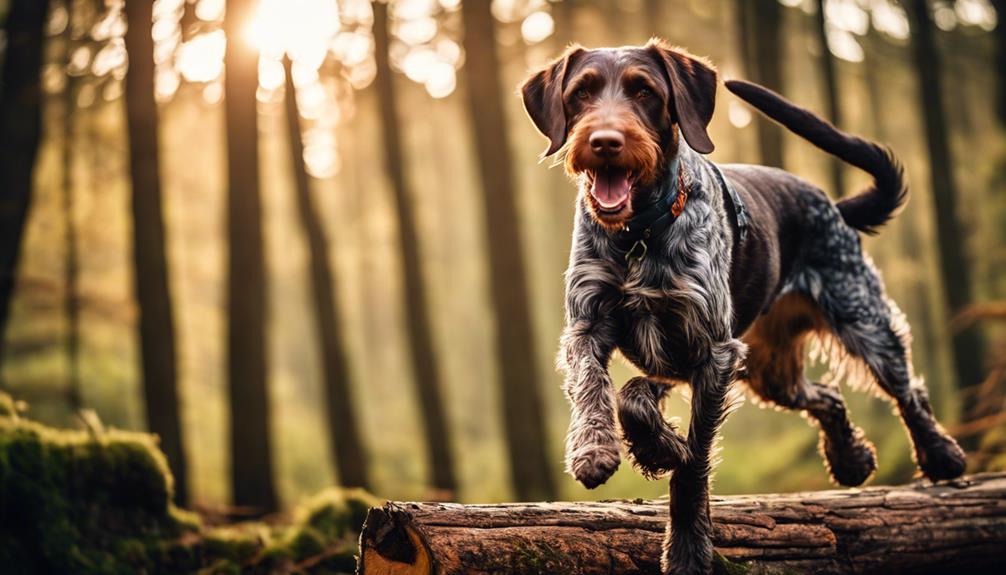
The German Wirehaired Pointer is a perfect blend of loyalty and vitality, traits that define its very essence. These dogs are not only great companions but also excel in various working environments. Let’s break down what makes them so special:
Their loyalty to their owners is unparalleled, making them faithful companions. They form deep connections with their families, always ready to show their affection and dedication.
Their energy levels are through the roof, requiring daily, energetic activities to stay happy and healthy. This zest for life makes them the ideal partner for outdoor adventures.
As a working breed, their intelligence and versatility shine when given tasks to accomplish. Whether it’s hunting or agility training, they tackle challenges with eagerness.
Their coats are built to withstand different weather conditions, demonstrating their adaptability. This resilience allows them to perform excellently in both cold and warm climates.
Unmatched Loyalty
German Wirehaired Pointers are known for their loyalty and energetic nature. They form a special bond with their families, making them more than just pets. These dogs need plenty of exercise and mental stimulation to stay happy.
Their loyalty isn’t just about sticking by your side; it’s about wanting to be involved in your life and activities. The strong connection they build with their owners showcases their commitment and love.
This breed’s dedication to their human companions is what sets them apart, highlighting a deep affection that lasts.
High Energy Levels
German Wirehaired Pointers are known for their loyalty and vibrant energy, making them a perfect fit for active families. These dogs need a lot of exercise to stay healthy and happy. They are not only loyal but also smart, showing their intelligence through various tasks.
These canines love to be mentally and physically challenged, which helps them use their natural instincts in a constructive way. Activities like searching and retrieving are great for keeping them engaged. This not only meets their high-energy demands but also strengthens the bond between the dog and its family, ensuring a joyful and fulfilling life for these enthusiastic pets.
Working Breed Traits
German Wirehaired Pointers are known for their loyalty and high energy, traits that stem from their working breed heritage. They form strong bonds with their owners and are always eager to take on new tasks.
Being part of the working breed family means these dogs need plenty of exercise and mental challenges to stay happy and healthy. They thrive when given jobs that test both their body and mind, making them excellent hunting partners.
Their mix of vigor and dedication not only makes them loving family pets but also skilled in various work situations where agility, stamina, and smarts are key.
Weather-Resistant Coats
The German Wirehaired Pointer is built to withstand tough weather conditions, thanks to its specialized coat. This coat is unique because it’s like wire and repels water, acting as a protective layer against wetness and cold. The hair varies in length, typically between one to two inches, making it a perfect shield against the weather. The coat is designed with shorter hair on the lower legs and toes for extra warmth. The breed standard is strict about the coat’s length and texture – too short, smooth, soft, woolly, or overly long coats are not desirable because they compromise the dog’s ability to handle different climates. Even as puppies, these dogs have coats that protect them from the weather.
The German Wirehaired Pointer stands out for its ability to adapt to harsh environments. The coat’s wire-like texture and water-repellent properties are key to this breed’s resilience. Short hair in certain areas provides additional insulation, ensuring the dog stays warm. The specific requirements for the coat’s appearance underline the importance of these features for the dog’s well-being in various weather conditions. From a young age, these dogs are equipped to brave the elements, showcasing the breed’s remarkable adaptability.
Devotion to Owners
German Wirehaired Pointers are known for their durable coats and dynamic energy, making them great family pets. They show deep loyalty to their owners, building strong relationships with the whole family. Despite possibly favoring one person, they can still form close bonds with everyone in the household. These dogs love being involved in activities with their humans, showing how affectionate and eager they are for companionship. Their love for adventure and willingness to participate in family activities demonstrate their strong loyalty.
These dogs are perfect for families looking for an active and loyal companion. Their need for interaction means they’re great for people who enjoy outdoor activities and spending quality time with their pets. German Wirehaired Pointers thrive on being part of the family, showing their love through constant companionship and loyalty. This breed’s ability to connect with all family members makes them ideal for households ready for an energetic and devoted pet.
Hip Dysplasia Screening
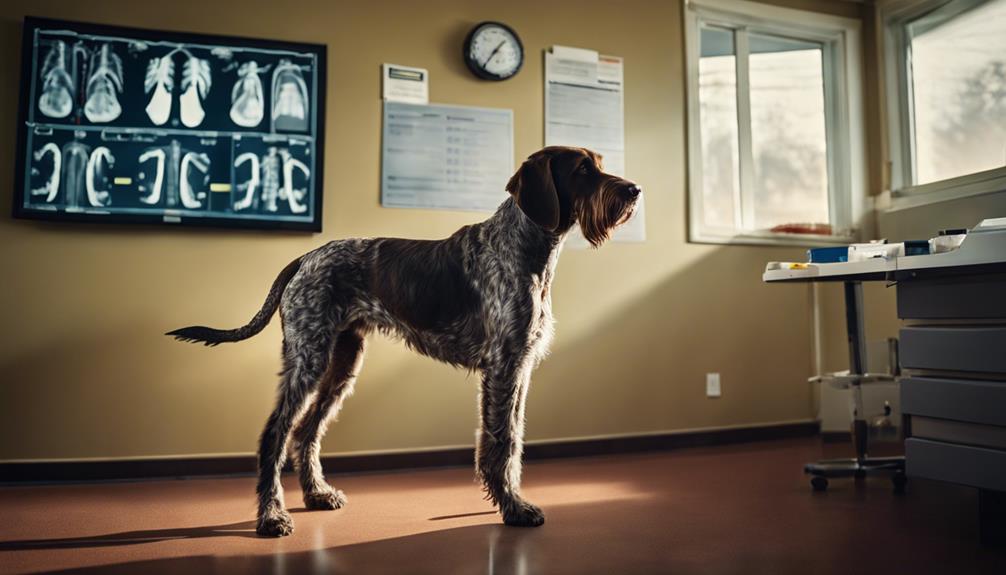
When we talk about hip dysplasia screening for German Wirehaired Pointers, we’re addressing a crucial step in both spotting and managing a common genetic issue. Screening not only helps catch the disorder early but also plays a crucial part in stopping its spread to the next generation of dogs. Here’s a simplified breakdown of what you need to know:
Understanding the genetic factors and how common hip dysplasia is among German Wirehaired Pointers is the first step. This breed, like many others, can inherit the condition, making screening a key part of responsible dog ownership.
An explanation of the radiographic (X-ray) screening method for this condition is also vital. This process allows veterinarians to get a clear look at the dog’s hip joints and assess any potential issues.
Knowing how to manage hip dysplasia if your dog is affected is crucial. This can include anything from dietary changes and physical therapy to, in more severe cases, surgical interventions.
Finally, the role of responsible breeding cannot be overstated. Breeders have a responsibility to ensure that dogs with hip dysplasia are not used for breeding, thereby reducing the likelihood of the condition being passed on to puppies.
In short, hip dysplasia screening in German Wirehaired Pointers involves understanding the condition’s genetic basis, utilizing X-rays for detection, managing the disorder in affected dogs, and practicing careful breeding to lower its incidence. This multi-pronged approach is key to maintaining the health and well-being of this beloved dog breed.
Identifying Hip Dysplasia
To spot hip dysplasia in German Wirehaired Pointers, vets often use X-rays to check the hips. This common issue in the breed needs a close look to find any problems with how the hip fits together. The X-ray is a key way to see if the hip joint matches up right, which helps vets figure out if there’s hip dysplasia and how bad it is. Signs that might make a vet want to do this test include the dog limping, having a hard time getting up, and not being as active. It’s a good idea to test dogs before they have puppies to help stop this genetic problem from spreading. Finding it early is critical to help manage the condition, making a big difference in the dog’s life through the right treatment.
Screening for hip dysplasia is not just about catching it early; it’s about ensuring these dogs can live full, happy lives. When breeders and pet owners stay informed and proactive, they contribute to the health and wellbeing of not just their own pets, but the German Wirehaired Pointer breed as a whole.
Screening Process Explained
Knowing how to spot hip dysplasia early in German Wirehaired Pointers is key to managing this common genetic issue. Since hip dysplasia affects many dogs in this breed, a detailed check-up is crucial for their health. The go-to way to find out if a dog has hip dysplasia is through X-ray exams. These help see how well the hip joints are doing.
The Orthopedic Foundation for Animals (OFA) runs a well-known program for checking dogs’ hips, which both vets and breeders use a lot. It’s important for breeders to test their dogs for hip dysplasia. Doing this helps make sure the problem doesn’t get passed on to puppies.
Catching hip dysplasia early is very important. It means the condition can be managed more effectively in German Wirehaired Pointers, helping them to lead healthier lives.
Managing Dysplasia Effects
Effective management of hip dysplasia in German Wirehaired Pointers requires a comprehensive strategy. This includes spotting the issue early through health screenings, using thoughtful breeding to minimize future cases, and caring for dogs to maintain their mobility and life quality.
Hip dysplasia affects many dogs in this breed, leading to unstable and painful hip joints. Regular x-rays can help catch this condition early, allowing for better management.
Proper breeding practices are key to reducing the chances of hip dysplasia in puppies. For dogs that do develop the condition, managing their weight, keeping their exercise at a healthy level, and using joint supplements can make a big difference. These steps help keep their joints as healthy as possible, ensuring they can enjoy a fulfilling life despite their condition.
Grooming Essentials
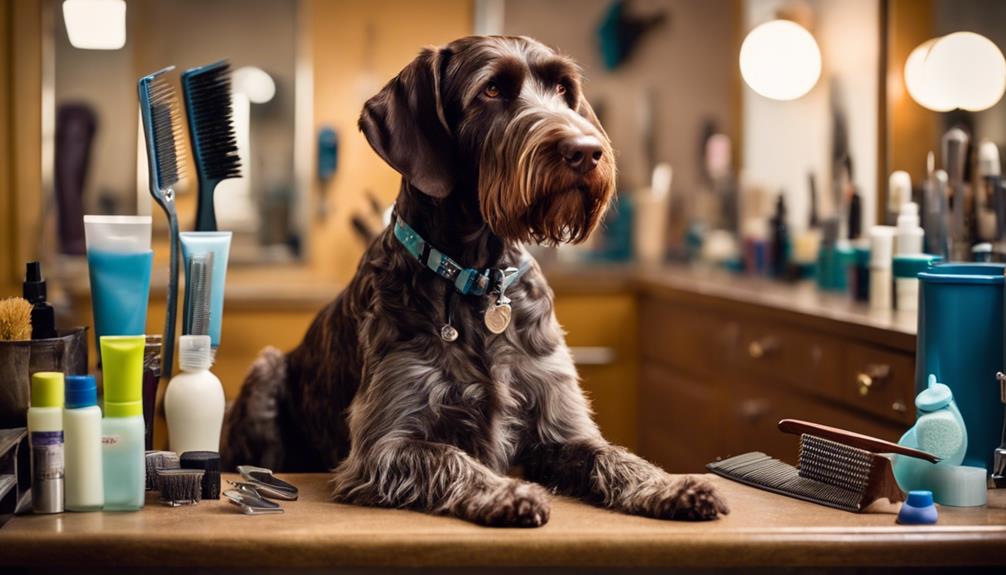
Caring for a German Wirehaired Pointer involves more than just keeping them looking good. It’s crucial for their health and happiness to maintain their unique coat and hygiene through various grooming practices. Here’s a straightforward guide to help you keep your German Wirehaired Pointer in top shape:
Coat Care Tips
A healthy coat starts with regular grooming. Using the right tools to comb through their wirehaired coat helps prevent mats and keeps their fur healthy. It’s not just about looks; a well-groomed coat protects the skin underneath.
Brushing Know-How
Invest in a quality brush suitable for their coat type. Brushing a few times a week reduces shedding and keeps their coat shiny. It’s also a great way to bond with your dog while checking for any skin issues.
Nail Maintenance
Keeping nails trimmed is more than cosmetic; it’s vital for their comfort and mobility. Long nails can lead to discomfort and even skeletal damage over time. Regular trims ensure your dog can walk and run pain-free.
Bathing Schedule
Unlike some breeds, German Wirehaired Pointers don’t need frequent baths. Washing them only when necessary helps maintain natural oils in their coat, which are essential for skin protection. Using a dog-specific shampoo will keep their coat healthy and prevent skin irritation.
Incorporating these practices into your routine ensures your German Wirehaired Pointer not only looks good but feels great too. Remember, grooming is a key part of pet care that affects their overall well-being.
Coat Maintenance Tips
To keep the German Wirehaired Pointer’s coat in top shape, it’s essential to brush it regularly and hand-strip it now and then. This breed’s coat is unique because it’s water-repellent and keeps the dog safe from bad weather. Its hair is straight and can be anywhere from one to two inches long. This means it needs a bit of work to stay looking good. The hair is shorter on the lower legs and between the toes, so you should pay extra attention to these areas when grooming.
Using the right tools makes all the difference. A slicker brush, stripping knife, and grooming glove can help keep the coat neat and tidy. If hand-stripping sounds tricky or you’re getting your dog ready for a show, you might want to get help from a professional groomer. They have the skills to make sure your dog’s coat keeps its special qualities, which not only makes your dog look great but also keeps them healthy.
Brushing Techniques
To keep your German Wirehaired Pointer’s coat looking great and healthy, proper brushing is key. Use a firm bristle brush to get through their tough, wire-like coat, which helps get rid of dead hair and stops mats from forming. When you find tangles, especially around the legs, chest, and tail, a slicker brush can carefully untangle them. Don’t forget about the dog’s beard and eyebrows; a comb or brush works well to keep those areas clean and neat.
Regular grooming isn’t just about looks; it also spreads the dog’s natural oils, making their skin healthier and their coat shinier. Plus, spending time grooming your dog is a great way to strengthen your bond. Keeping up with these grooming habits ensures your German Wirehaired Pointer stays in top condition.
Nail Care Essentials
For German Wirehaired Pointers, keeping their nails trimmed is key to their well-being and comfort. Letting nails grow too long can lead to splitting or even injury. Not only is this painful, but it can mess with their walk and posture, possibly causing long-term health problems. Keeping their nails short through regular grooming helps them move more easily and stay comfortable.
Using the right tools and methods is crucial for trimming a German Wirehaired Pointer’s nails without causing them stress or injury. Nail care is not just about looks; it’s vital for their health and hygiene, requiring regular checks and maintenance by the dog’s owner.
Bathing Frequency
Finding the right bathing schedule for German Wirehaired Pointers is crucial. Ideally, you should bathe them every 6-8 weeks to keep their coat healthy. If your dog is more active or gets dirty often, you might need to adjust this frequency. Regular brushing and grooming can help you stretch out the time between baths, as it helps keep their coat in good condition and preserves the natural oils that protect their skin.
When it’s time for a bath, choosing the right dog shampoo is key. Opt for a product that’s made for wirehaired breeds to avoid irritating their skin. Making sure your dog is thoroughly dry after a bath is also important. This step prevents skin issues and ensures their coat continues to protect them from the weather, keeping your German Wirehaired Pointer looking and feeling great.
Ear Cleaning Guide
Taking care of a German Wirehaired Pointer’s ears is crucial for their health. Regular cleaning with vet-approved products is key to avoiding infections and keeping their ears healthy. Use soft cotton balls to gently clean the inside of their ears, but steer clear of cotton swabs or anything sharp that could hurt their ear canal.
It’s important to check their ears often for any signs of trouble like redness, swelling, discharge, or bad smells, as these could mean an ear infection. Keeping up with a consistent ear cleaning routine will help keep your dog’s ears in top shape, which is a big part of their overall care.
Dietary Needs

The dietary needs of the German Wirehaired Pointer, a breed celebrated for its energy and durability, involve several key factors essential for keeping them healthy and active. These factors include:
Nutritional Balance is vital, requiring a well-rounded diet that includes proteins, fats, carbs, vitamins, and minerals. This ensures the dog has all it needs for energy, growth, and health.
Choosing the Right Food and Portions is about opting for quality foods, whether commercial or homemade, and serving the right amount to prevent both underfeeding and overfeeding. It’s crucial for maintaining the dog’s ideal weight and overall health.
Weight Management involves keeping an eye on the dog’s weight and adjusting its diet as needed. This step is important to avoid obesity and the health issues that come with it.
Understanding and applying these principles will help ensure that a German Wirehaired Pointer stays in top shape.
Nutritional Requirements
German Wirehaired Pointers need a diet full of high-quality protein to keep up with their active lifestyle. It’s crucial to find a diet that’s specially made for medium to large dog breeds to ensure they’re getting the right nutrients.
These dogs also need essential fatty acids in their meals to keep their unique coat shiny and healthy. Since they’re very energetic, it’s important to watch how much they eat to avoid weight gain.
Talking to a vet can help figure out the best food based on the dog’s age, how active they are, and their health.
Food Types & Portions
German Wirehaired Pointers thrive on a diet that includes plenty of high-quality protein, healthy fats, and important vitamins and minerals. These components are essential for their active lifestyle, helping them maintain their energy and health. Protein is key for muscle maintenance and growth, while fats fuel their activities throughout the day.
Vitamins and minerals play a critical role in keeping their immune system strong, bones healthy, and overall condition in top shape. Managing how much they eat is also important. Too much food can lead to weight gain, which might cause joint problems and other health issues. A regular feeding routine can help keep their digestive system running smoothly and energy levels consistent.
Talking to a vet is the best way to figure out the right food and how much to feed your German Wirehaired Pointer. This advice will ensure they get the nutrition they need without overfeeding.
Managing Weight Control
Keeping a German Wirehaired Pointer at a healthy weight involves a well-balanced diet and regular exercise. It’s important to feed them high-quality dog food that meets their energetic needs without causing weight gain. Due to their high energy, these dogs need plenty of exercises to stay fit. Watching how many treats and snacks they get is key to avoiding extra calories.
For the best advice on feeding and exercise, talking to a vet or a dog nutrition expert is a smart move. They can help create a custom diet plan that’s perfect for your dog’s health and happiness.
Frequently Asked Questions
Is a German Wirehaired Pointer a Good Family Dog?
- German Wirehaired Pointers adapt well to families with training.
- They need consistent training for best behavior.
- Great companions for active lifestyles.
Are German Wirehairs Aggressive?
- Aggression isn’t tied to breed but to upbringing.
- Positive training reduces aggressive behavior effectively.
- Socialization and care are key to a well-behaved dog.
Do German Wirehaired Pointers Bark a Lot?
- German Wirehaired Pointers usually don’t bark much.
- Proper training cuts down on barking.
- Exercise and play fulfill their needs.
Do German Wirehaired Pointers Shed Hair?
- German Wirehaired Pointers shed less.
- Brushing keeps their coat healthy.
- Suitable for allergy sufferers.

